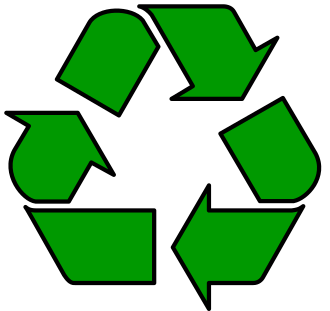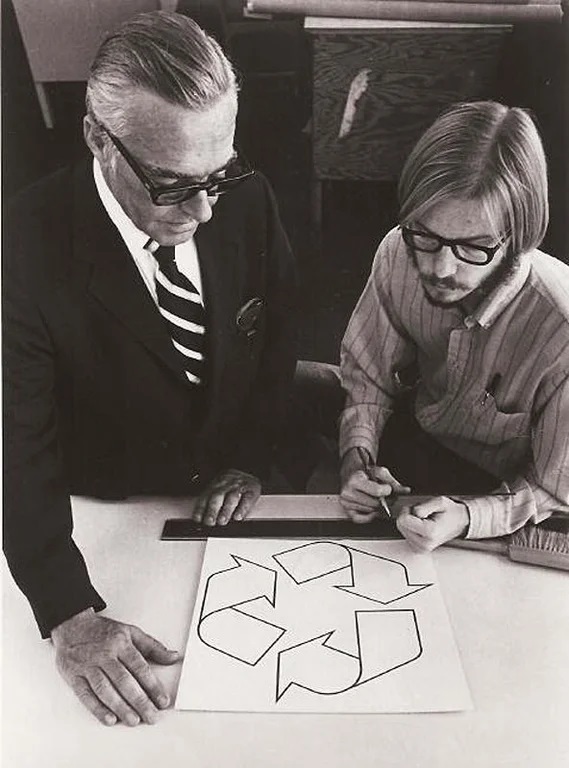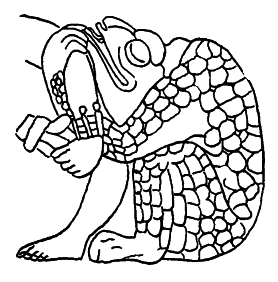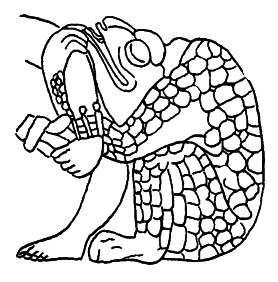Recycling of Recycling
logo

Recycling of Recycling
logo

The creation of the recycling logo by Gary
Anderson, 23 at the time. (1970)
| Recycling is the process of converting waste materials into new materials and objects. The recovery of energy from waste materials is often included in this concept. The recyclability of a material depends on its ability to reacquire the properties it had in its original state.[1] It is an alternative to "conventional" waste disposal that can save material and help lower greenhouse gas emissions. It can also prevent the waste of potentially useful materials and reduce the consumption of fresh raw materials, reducing energy use, air pollution (from incineration) and water pollution (from landfilling). | リサイクルとは、廃棄物を新しい材料や物に変換することである。廃棄物
からエネルギーを回収することも、この概念に含まれることが多い。材料のリサイクル性は、元の状態が持っていた特性を再び獲得できるかどうかで決まる。従
来の」廃棄物処理に代わる方法として、材料を節約し、温室効果ガス排出量の削減に貢献することができる。また、潜在的に有用な材料の浪費を防ぎ、新鮮な原
材料の消費を抑えることができるため、エネルギー使用量、(焼却による)大気汚染、(埋め立てによる)水質汚染も減らすことができる |
| Recycling is a key component of
modern waste reduction and is the third component of the "Reduce,
Reuse, and Recycle" waste hierarchy.[2][3] It promotes environmental
sustainability by removing raw material input and redirecting waste
output in the economic system.[4] There are some ISO standards related
to recycling, such as ISO 15270:2008 for plastics waste and ISO
14001:2015 for environmental management control of recycling practice. |
リサイクルは現代の廃棄物削減の重要な要素であり、「リデュース、リ
ユース、リサイクル」という廃棄物ヒエラルキーの3番目の構成要素である。
経済システムにおいて、原料の投入をなくし、廃棄物の出力を方向転換することで、環境の持続可能性を促進するものである。プラスチック廃棄物に関する
ISO 15270:2008、リサイクル実務の環境管理制御に関するISO 14001:2015など、リサイクルに関連するISO規格がある |
| Recyclable materials include
many kinds of glass, paper, cardboard, metal, plastic, tires, textiles,
batteries, and electronics. The composting and other reuse of
biodegradable waste—such as food and garden waste—is also a form of
recycling.[5] Materials for recycling are either delivered to a
household recycling center or picked up from curbside bins, then
sorted, cleaned, and reprocessed into new materials for manufacturing
new products. |
リサイクル可能な材料には、ガラス、紙、段ボール、金属、プラスチッ
ク、タイヤ、繊維、電池、電子機器など、さまざまなものがある。生ゴミや庭ゴミなど、生分解性のゴミを堆肥化して再利用することもリサイクルの一種であ
る。リサイクルのための材料は、家庭用リサイクルセンターに届けられるか、またはゴミ箱から回収され、選別、洗浄され、新しい製品を製造するための新しい
材料に再加工される。 |
| In ideal implementations,
recycling a material produces a fresh supply of the same material—for
example, used office paper would be converted into new office paper,
and used polystyrene foam into new polystyrene. Some types of
materials, such as metal cans, can be remanufactured repeatedly without
losing their purity.[6] With other materials, this is often difficult
or too expensive (compared with producing the same product from raw
materials or other sources), so "recycling" of many products and
materials involves their reuse in producing different materials (for
example, paperboard). Another form of recycling is the salvage of
constituent materials from complex products, due to either their
intrinsic value (such as lead from car batteries and gold from printed
circuit boards), or their hazardous nature (e.g. removal and reuse of
mercury from thermometers and thermostats). |
例えば、使用済みの事務用紙は新しい事務用紙に、使用済みの発泡スチ
ロールは新しい発泡スチロールに生まれ変わる。金属缶のように、純度を落とさずに何度でも再生できる材料もあるが、他の材料ではそれが困難であったり、
(原料や他の供給源から同じ製品を製造するのに比べて)コストがかかりすぎたりするため、多くの製品や材料の「リサイクル」には、別の材料(例えば板紙)
の製造に再利用することが含まれる。また、自動車用バッテリーからの鉛、プリント基板からの金など、製品本来の価値や、体温計やサーモスタットからの水銀
の除去・再利用など、危険な性質を持つ複合製品から構成材料を回収することもリサイクルの一形態と言える |
リンク
文献
その他の情報
Copyleft, CC, Mitzub'ixi Quq Chi'j, 1996-2099


